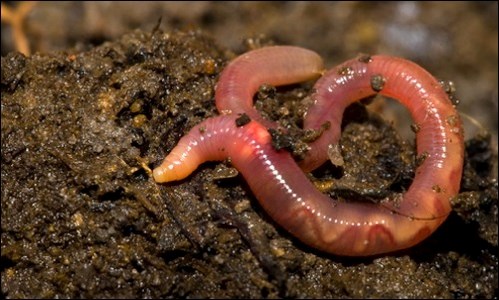Are earthworms good for your garden? Many gardeners believe that earthworms are a benefit while those who garden in a very heavy clay soil would be quick to disagree.
There are many studies that show earthworm activity helps to form better soil aggregates which in turn will help soil to support better plant growth with less compaction and erosion. Just compare the difference earthworms can make in the production of topsoil. It might take 500 to 1,000 years for nature to produce topsoil in the absence of a adequate soil animal population. However, under favourable conditions earthworms can shorten this process to a little as five years. This is because of the ability for earthworms to mix, till and build topsoil as they go about their daily business of burrowing through the earth.
The most “common” species of earthworm we would encounter is Lumbricus terrestris and it is amazing to learn the lowly earthworm has not been an inhabitant of North America forever. In fact, only after the last glaciations period have earthworms been introduced to our lands.
Beneath lawns, earthworms are amazing. They help to improve water infiltration, which leads to a deeper rooted lawn. This of course helps lawns to better withstand periods of drought. Earthworms help to increase soil organic matter by bringing deeper soil closer to the surface. This helps to decompose leaf litter (which reduces thatch) and amends the soil without any effort on behalf of the gardener. The only drawback is sometimes earthworm activity can leave lumps, which are distressful to some lawn fanciers.
If you can see these lumps from earthworms then you are very likely mowing your lawn a bit short. Try adjusting your mower height to ensure your lawn has lots of leaf tissue left after a mowing to help facilitate optimum growth. A lawn that is cut to about 2.25 inches is a healthy lawn. If these lumps make your lawn uncomfortable under foot then simply rolling your lawn will alleviate this distress.
However, in a heavy soil earthworm activity seems to make all the problems of a clay soil a little bit worse. The earthworm castings seem to be sticky, gloppy masses of close to concrete, not the type of soil conducive to plant growth. Over the years, I have been asked numerous times how to eradicate this pest.
There is no instant, magical way to eradicate earthworms with a spray or drench. In fact, even trying to do so would be devastating to all living organisms in the soil that help make up the great diverse environment in the soil we cannot see. If you have a heavy soil and find earthworms are not helping, the best solution is to add lots of organic matter.
In effect you will be “feeding the worms” and giving them more organics to break down and improve your non-friable soil. Use coarser organics like grass clippings and chopped leaves to provide lots of munching prior to becoming humus. Do not give up as this process will take some time, and lots of organic matter.
We as gardeners are always trying to improve the soil tilth, but it is always a short-term solution. Earthworms, believe it or not, are the best long-term solution for a healthy soil as they are able to: improve the soil structure, mix and till the soil, help in humus formation and increase the availability of nutrients in the soil.
Next time you get concerned about too many earthworms, remember that they are the army building your soil into a better entity, and perhaps instead of worrying about them, take you spade out to the garden, dig a few earthworms and go fishing.
— Hanbidge is a horticulturist with the Saskatoon School of Horticulture and can be reached at 306-931-GROW(4769); by email at [email protected] or check out our website at www.saskhort.com




